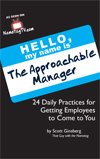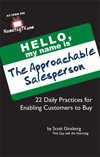 “I bow to you.”
“I bow to you.”
That’s the literal translation of the Sanskrit word namaste.
And although it’s primarily used as a greeting or salutation in Indian, Buddhist and Asian cultures/faiths, there’s no reason you can’t embrace the spirit of namaste in your own daily life.
I first experienced this philosophy when I started taking Bikram Yoga. At the end of each class – right before our instructor walked out of the room and left us to our final meditation – she would conclude by saying namaste. Then, as a gesture of respect and gratitude, all of the students would repeat namaste in unison as she exited.
Well, almost all of the students. Personally, I was so exhausted, out of breath and out of fluids that I could barely keep my eyes open, much less articulate a three syllable word.
Eventually – somewhere around my tenth or so class – I finally came around.
That’s when I learned that the word namaste also translates to: “The spirit within me honors the spirit within you.”
And I thought, “Cool. What a beautiful concept. I wonder if there are other areas of life in which we could apply namaste…?”
That was about 18 months ago. Since then, I’ve been collecting a list of practices that transports this sacred philosophy into our daily interactions. (Especially the areas of communication where I need the most work!)
So, as you read each of these examples, I challenge you to ask yourself three questions:
(1) How do I feel when others do this for me?
(2) How well am I currently practicing this in my own life?
(3) What are some ways I could improve the way I practice this in my own life?
1. Embrace their pace. Listening is midwifing. It’s about helping the other person give birth to her own understanding. It’s about facilitating a natural process. Enabling and nurturing the speaker’s rhythm guiding him to make the best choices. Ultimately, the goal is to provide assistance, NOT authority. That way he can see, find, say, do, know, learn and discover by his own accord.
TRY THIS: Resist the need to take over. Respect the speaker’s speed of self-discovery. No pushing. No forcing. Gentle nudging. Embrace their pace. Suspend conversational control. Allow people to safely process their own thoughts and solutions. Namaste. The spirit in me honors the spirit in you.
TRY THIS: Frame answers with alternatives. Instead of giving advice, pose questions so the other person can hear more deeply what his heart is saying. Ask, “What are your options?” This objective response doesn’t take over someone’s problems. It allows him to dig for the answer on his own.
Also, the use of the word “options” indicates multiple possibilities for solutions. What’s more, this response avoids telling someone what they, “should” do, while still offering a potential solution. Namaste. The spirit in me honors the spirit in you.
ASK THIS: How are you inviting discovery? How are you creating a space where people can see the solutions in themselves? And how would people’s perception of your leadership ability change if THEY were the ones who felt like they always discovered the solution?
2. Give people the time and space they need to fully express themselves. In Parker Palmer’s fantastic book about listening and leadership, A Hidden Wholeness, he talks about being hospitable to the soul.
“Make each soul feel safe enough to show up and speak its truth,” he explains. “Create a space that invites the soul to make itself known or you will scare it away and drive that which is original and wild into hiding.”
Wow. Imagine what would happen to your perception as a leader and listener if you practiced that.
TRY THIS: Resist your impulse to fix. Just be. Abandon the arrogance of believing you have the answer to the person’s problem. “It’s not a problem to be solved but a mystery to be honored,” Palmer suggests.
So, don’t try to save people – just be present to them. Stand with simple attentiveness. Your faith in them will bolster their own faith in themselves. Namaste. The spirit in me honors the spirit in you.
TRY THIS: Approachability is just as much about what you don’t do. Examples: Don’t fix. Don’t invade. Don’t evade. Don’t advise. Don’t set straight. Don’t influence. Don’t pressure. Don’t answer. Don’t save. Don’t analyze. Don’t insert opinions and agendas. Don’t advance your self-image.
I know it’s a lot to keep track of, but if you fall victim to these egoic tendencies, you risk contaminating the listening space and scaring people’s truth away. Namaste. The spirit in me honors the spirit in you.
ASK THIS: Are you listening or waiting talk? Are you leading or superimposing your beliefs on others? And how do you plan to create the space people need to exert their distinctiveness?
3. Help people unravel deeper significance. The only way to accomplish this is to create a safe container in which the person can share. Remember: A person’s soul is shy. You don’t want to scare it away. Still, people need to feel essential. Not important. Not valued. Not special. ESSENTIAL.
TRY THIS: Let what people say have an impact on you AND them. For example, when someone makes a profound comment, asks a killer question or juxtaposes words in a beautifully unexpected way, PAUSE. This silent space allows deep, creative ideas to surface. Which gives someone the stage her words deserve. Which gives that person the opportunity to let their original idea truly resonate down to THEIR core.
Like my doctor says, “If you wait long enough, your patient will tell you the diagnosis.” Namaste. The spirit in me honors the spirit in you.
TRY THIS: After holding a person in a loving space where she is compelled to listen to herself, send reinforcements for her unraveling process. Here’s how: When you review your notes from the conversation, extract all of the keepers, nuggets and epiphanies that surfaced and email them to the other person.
In the subject line write, “13 Keepers from Our Conversation Yesterday.” Then write, “Karen, thanks for sharing your powerful insights yesterday. Really got me thinking! I wrote a few of them down for your reference…” Guarantee it will both unravel deeper significance and make her feel essential. Namaste. The spirit in me honors the spirit in you.
ASK THIS: How are you helping people help themselves? Have you accepted silence as a normal part of your conversations? And how are you following up with people to make sure they listen to themselves?
4. Open your receptors to the other person’s subtleties. Listening is about listening FOR things. Even if you don’t agree. Even if you don’t approve. That’s all part of namaste – the honoring. The accepting. The loving.
So, begin by listening for language patterns: Listen for what they say, listen for what they don’t say, listen for what they’re not telling you, listen for what the person is trying to communicate, listen for what thoughts they share first, listen for what thoughts they share last, listen for what is emphasized and listen for what is downplayed.
Also, listen for opportunities: Listen for what is pushing the person, listen for their ideas of how they want things to be, listen for how to remove resistance, listen for what the person would need, listen for others’ interests and listen for areas where people are afraid and hurt.
TRY THIS: Say what you see. Use Phrases That Payses like, “I had an observation,” “I noticed,” and “My intuition is telling me that…” The three secrets are: (1) Observe, don’t accuse; (2) insinuate, don’t impose; and (3) describe, don’t prescribe. Otherwise people won’t open up, become defensive and assume you’re trying to “fix” them. Namaste. The spirit in me honors the spirit in you.
TRY THIS: Count behaviors. If you’re taking notes when working with someone, keep a discreet tally of certain tendencies, i.e., “The number of times he says the word ‘but’” or “The number of sentences he starts with the word ‘I can’t…’”
After a certain point, turn your paper 180 degrees and show them your tally. Explain what it stands for and then wait for a response. This objective, non-judgmental style of feedback is not only respectful, but doesn’t challenge someone’s character or attitude. Namaste. The spirit in me honors the spirit in you.
ASK THIS: What are you listening for? What are you listening with? And what do you plan to do with what you hear?
5. Understand, honor and respond to their unique experience of the world. My definition of empathy is, “The ability to look at the world through different value systems.” This means placing special or unique value in everything people share with you. This means not trying to change the situation, but rather, thinking new ways to experience it that would make a positive difference in how you feel.
TRY THIS: Change your relationship to your emotions. Don’t allow your defensiveness to block your receptivity to someone else’s truth. Especially when there’s a conflict of opinions. Instead, view disagreements as if they were celebrations of ideas. You will listen with a more open (and less defensive) posture.
TRY THIS: Be on the lookout for subtle, external cues about what people are really like. Keep your receptors open for indicators of their core, their truth: What they value, what makes issues important in their lives, what their vision and purpose is, what they treasure and what makes them come alive. Namaste. The spirit in me honors the spirit in you.
ASK THIS: Do your comments honor the other person’s unique feelings, thoughts and emotions? Have you lost track of this conversation because of the inner conversation you’re having with your ego? And what is preventing your ears from opening in this conversation?
6. The correct answer is whatever they learned.. So, honor whatever surfaces. Dance in the moment. Believe that perfection is unfolding right before your eyes. Then, help them embrace this perfection so you both can feel rightness and appropriateness in the encounter.
TRY THIS: Pick something ordinary that they said and brainstorm all the reasons you can of for its perfection. Then email that list to them the day after your conversation. They’ll never forget it. Namaste. The spirit in me honors the spirit in you.
TRY THIS: Acknowledge their rising thoughts and feelings. During a conversation with someone, presence is the secret and anticipation is the enemy. Ask yourself one question: “What is the truth at this particular moment?” That will help keep you present. Namaste. The spirit in me honors the spirit in you.
ASK THIS: What are you missing out on because of the need to be right? How are you saying yes to What Is? And how can you build an environment where wrong answers are impossible?
– – –
REMEMBER: You don’t need to be a Yogi to honor the spirit of those you serve.
LET ME ASK YA THIS…
How are you practicing namaste?
LET ME SUGGEST THIS…
For the list called, “53 Not So Obvious Patterns Listeners Need to Listen For,” send an email to me, and I’ll send you the list for free!
* * * *
Scott Ginsberg
That Guy with the Nametag
Author, Speaker, Coach, Entrepreneur
[email protected]
 Never the same speech twice.
Never the same speech twice.
Always about approachability.
Watch The Nametag Guy in action here!
 FIRST: Pinpoint self-interest.
FIRST: Pinpoint self-interest.  If they can’t come UP to you; how will they ever get BEHIND you?
If they can’t come UP to you; how will they ever get BEHIND you?

 I play intramural kickball on Sundays.
I play intramural kickball on Sundays.
 Biography isn’t destiny.
Biography isn’t destiny. 
 If you work with one of those delightful people whose sole purpose in life is to flood your mental landscape with complaints, consider these five practices for approaching them with comfort and class:
If you work with one of those delightful people whose sole purpose in life is to flood your mental landscape with complaints, consider these five practices for approaching them with comfort and class: 1. Create a movement. Not a company. Not a product. Not a service. A movement. This requires a significantly higher level of passion, inner fire and tolerance for ambiguity. The cool part is, it’s more rewarding, more fun and more engaging. The challenging part is, you sleep a lot less. Oh well. Are you
1. Create a movement. Not a company. Not a product. Not a service. A movement. This requires a significantly higher level of passion, inner fire and tolerance for ambiguity. The cool part is, it’s more rewarding, more fun and more engaging. The challenging part is, you sleep a lot less. Oh well. Are you  “I bow to you.”
“I bow to you.”